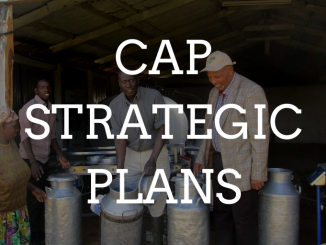Alan Matthews assesses the terrain of competing forces in CAP reform, before suggesting some radical changes post 2020 (or, 2022/23). These include a more targeted, results focused CAP for both farmers and member states, with a single pillar, co-financing and savings reinvested in public goods among the proposals.
The background note for this #AfterCAP: What’s Next? debate raises the question whether the CAP is at a crossroads (as suggested by the Slovak Presidency background paper for the November 2016 AGRIFISH Council meeting) and, if so, which direction should it take. Whether we are at a crossroads or not requires evaluating the balance of forces behind the 2013 compromise CAP outcome.

The 2013 CAP confirmed a continuing role for decoupled direct payments paid on a per hectare basis, increasingly justified as providing an income safety-net for farmers in the light of increased market price variability in recent years. It transformed a significant share, 30%, of these payments into a greening payment intended to reward practices favourable for the climate and the environment. It created a crisis reserve mechanism which relies on redistributing the direct payments envelope among farmers (internal solidarity). It strengthened the mechanisms for cooperation among producers. It redesigned rural development programmes around six priorities and, in general, gave a lot more flexibility to Member States regarding how they wanted to implement both Pillar 1 and Pillar 2 measures.
There are few stakeholders who seem satisfied with this outcome. Farmers dislike the additional requirements imposed to receive ‘their’ payments and argue that the CAP mechanisms have not provided an adequate response to the cyclical drop in farm incomes over the past two years. Member State administrations complain about the complexity of the new rules and the legalistic enforcement by the Commission. Environmentalists are dismayed that there is little evidence of improved environmental outcomes from the greening payment. The slow approval of rural development programmes delayed the start of the new CAP by one year.
Read: the #AfterCAP Debate in full
The Commission has promised to consult widely on the ‘modernisation and simplification’ of the CAP. The report of the Agricultural Markets Task Force was published earlier this week, and the Commissioner will give some indication of his political priorities before the end of this year. A Communication from the Commission is now expected in the second half of next year. With limited time in the current parliamentary term which will end after the first quarter of 2019 and a new Commission taking up office in October 2019, what proposals might be expected to emerge from these initiatives?
Some changes will be expected on market management and risk management. Supporters of a more interventionist CAP will point to the voluntary supply reduction scheme introduced in the dairy sector and may try to make this a more permanent fixture of the CAP. The Agricultural Markets Task Force has recommended that the EU’s risk management toolkit should be made more attractive as well as become a mandatory element in Member State’s rural development programmes. It has proposed that funding should be shifted from direct payments to fund “a genuine and predictable safety-net for farmers to apply in times of market imbalance”. There is some support in the Parliament to introduce counter-cyclical payments in the EU, following the US example, although such a major reversal of the past trajectory of CAP reform is unlikely to be widely supported.
It is much less clear what initiatives might be expected to help improve the environmental outcomes of land management and the sustainability of EU farming more generally. The focus to date in this area has been on ‘simplification’ rather than ‘modernisation’. Agriculture faces significant challenges in reducing its greenhouse gas emissions as well as in adapting to climate change. There is an urgent need to step up action to protect biodiversity as well as to restore healthy soils. But there is little agreement, also among environmental NGOs, whether these goals can be best achieved by building on the existing greening payment or by starting afresh.
In a recent paper for the European Parliament’s AGRI Committee, I tried to provide guidance on how to chart a course for the CAP beyond 2020. There are four core chapters in the report. The first summarises how the CAP 2013 reforms have been implemented in Member States. The second chapter provides a critique of decoupled direct payments. It concludes that these payments are not an effective instrument to address the challenges facing EU farming, they are not equitably distributed, and they are not an efficient use of taxpayers’ money.
The third chapter discusses options for incremental changes to the current CAP, which would maintain the existing structure as set out in the four basic acts but adjust specific aspects. This might be the most likely outcome given the political constellation around further CAP reform at this point in time, but incremental changes will not address the underlying weaknesses in the current policy.
The final chapter thus suggests the outline of a bolder approach to reform, which builds on a set of policy principles (I expand briefly on these principles in this blog post).
- Payments should be targeted on specific objectives with a clear results orientation.
- Payments should be restructured within a one-pillar, programmed, multi-annual CAP.
- National co-financing should be required for all CAP expenditure, with the degree of EU co-funding calibrated on the extent of EU value added of CAP expenditure.
- Decoupled direct payments should be gradually phased out over a pre-announced transition period.
- Savings should be redirected to more spending on risk management, improving competitiveness, climate action, environmental public goods and strengthened resilience and sustainability.
- Payment entitlements should be replaced by a contractual framework between farmers and public authorities.
- Cross-compliance and the greening payment should be replaced with ‘conditional greening’ whereby the receipt of public support would be conditional on enrolling in a basic (shallow) environmental scheme devised by the Member State.
- The allocation of budget resources should be incentive-based so that budgets are allocated to Member States based on performance as well as needs.
Whether there is an appetite to base a future CAP on these principles at this point in time remains to be seen. But it is unlikely that policy-makers can simply continue with the status quo or even incremental changes for budgetary reasons.
We do not yet know what the Commission is likely to propose for the CAP budget in the post-2020 spending period. Because of the Parliamentary timetable and the appointment of a new Commission in the second half of 2019, there is a suggestion that the current Multi-annual Financial Framework (MFF) may simply be extended for a further two or three years to 2022 or 2023. This would give the new Parliament and the new Commission the opportunity to shape the next MFF after they taken office. The expectation, in that scenario, is that the current CAP budget would be extended as well.
However, if Brexit occurs before those dates, it may not be possible to maintain the status quo given that the UK is a significant net contributor to the overall EU budget. There is the possibility that some of the gap left by the UK departure could be covered by alternative sources of finance. For example, the UK may continue to make a net contribution to the EU budget depending on the type of relationship it wishes to have with the EU after Brexit. If tariffs are re-imposed on UK-EU trade, this would raise a significant amount of additional ‘own resources’ which would offset the loss of the UK net contribution.
On balance, however, it seems probable that there will be less money available for the EU budget after 2020 and thus less money available for the CAP, even without any updating of the MFF to match new EU priorities such as investment, security and migration. In those circumstances, the single most important decision on the CAP after 2020 is whether the legislators decide to take account of a lower budget by reducing measures currently financed under Pillar 1 or measures currently financed under Pillar 2. Will the legislators prioritise per hectare payments to all farms or the more targeted measures including rewarding improved land management now funded under Pillar 2? This is likely to be the defining debate for the CAP after 2020.
Alan Matthews is Professor Emeritus of European Agricultural Policy at Trinity College Dublin, Ireland.
More
Debate #AfterCAP
#AfterCAP | One CAP, 32 national recipes – who is stirring the pot?
#AfterCAP | Towards an integrated rural development policy 2.0





